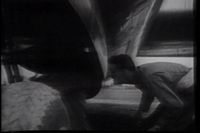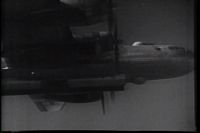
Famous Bombers of World War II: B-29
 |
The B-29 gets its first mission in the summer of 1943 at a meeting in Canada.
 |
The plan was to use the B-29 to bomb Japan from bases in China.
 |
The B-29 was quite new and there were still some bugs in the plane, such as overheating engines.
 |
Sept. 1940, the war department authorizes prototype B-29s to be built. Initial discussion about having such a plane began in the 30's.
 |
There was the XB 29 and the XB 32 prototypes, with the XB 29 proving to be the superior design, by Boeing. Around 4000 B-29s were built, but very few of the XB 32s were built.
 |
At the time, there was no guarantee that the bomber would work. It was very advanced for its time and very complicated. It was even pressurized.
 |
There's a lot of scenes in the factories of the planes being built, and its very fascinating.
 |
A lot of information is given about the plane, including length, wingspan, bomb load, etc.
 |
Here, the tail part of the plane is attached.
 |
In other planes, gunners actually manned the guns and shot them. In the B-29. a type of early computer helped the gunners who did not man the guns, but operated them by remote control.
 |
The plane before its engines were attached.
 |
The first prototype flew in Sept. of 1942. Another prototype crashed, though, raising doubts about the usefulness of the plane.
 |
By summer of 1943, production models of the plane were flying.
 |
The Chinese readied airfields (some 200,000 laborers were involved). Roosevelt had promised the planes by January of 1944, even though they were not yet fully tested.
 |
The Chinese had no concrete, so they used crushed stone to build the runways.
 |
Ten-ton stone rollers were pulled by hand to compact the stone.
 |
The first attack on Japan was scheduled for June of 1944.
 |
The first target would be Japanese steelworks in southern Kyushu.
 |
The attack would be at night at a height of 8,000 to 18,000 feet.
 |
One bomber crashed on takeoff and six others had to abort on this first mission.
 |
Nighttime navigation was difficult, and only 47 planes found their targets.
 |
Results were not good. Three planes crashed, one was destroyed after landing, and bombs sometimes fell twenty miles off target. Note: at this time, what they were using were regular bombs. Use of incendiaries came later.
The islands of Guam, Saipan and Tinian had to be captured. Once that was done, they could be used as much more practical airfields for the B-29s.
This is the 21st Bomber Command.
LeMay had some guns removed so the planes could carry more bombs. Once Iwo Jima was captured, there was an emergency airstrip for the planes which were still having some engine troubles. The missions to Japan could last around fifteen hours.
Japanese Zeroes would attack the B 29s and, at times, even ram them.
In March of 1945, bomb use was changed over to mainly incendiary bombs.
Military targets were no longer the only kind hit. Cities and civilians became targets.
16 square miles of Tokyo were destroyed on the first firebombing run. The incendiary attacks killed more Japanese than did the atomic bombs.
Since the Japanese still did not surrender, Truman gave the order for the use of the atomic bomb.
The surrender of Japan.
Main Index
Japan main page
Japanese-American Internment Camps index page
Japan and World War II index page
|
|